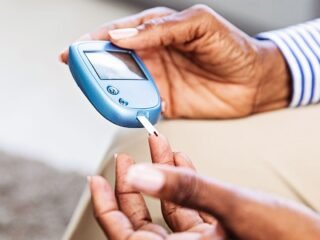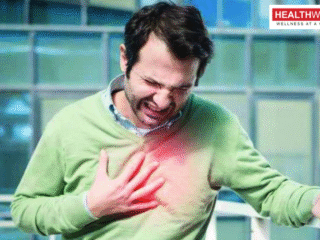New Delhi, 27 October, 2025: Can a sudden rise in cholesterol levels cause a stroke? It’s a question that many health experts are hearing more frequently as India grapples with an alarming rise in lifestyle diseases. While cholesterol has long been labeled a “silent killer,” recent studies and clinical evidence reveal that the connection between cholesterol spikes and strokes is more complex than most people think.
In this exclusive report, health specialists explain how cholesterol impacts the brain, why sudden spikes in lipid levels are dangerous, and what lifestyle choices can protect you from a life-threatening event like a stroke.
Understanding Cholesterol: Not All of It Is Bad
Cholesterol is a fat-like substance found in every cell of the body. It helps build cell membranes, produce hormones, and digest fat. The problem begins when cholesterol levels go out of balance.
There are two main types:
- LDL (Low-Density Lipoprotein): Commonly called “bad” cholesterol, high LDL can lead to plaque buildup in arteries.
- HDL (High-Density Lipoprotein): Known as “good” cholesterol, HDL helps remove excess cholesterol from the bloodstream.
When LDL levels rise sharply, it causes fatty deposits to accumulate along the arterial walls — a process known as atherosclerosis. Over time, these deposits narrow the arteries, restricting blood flow to the brain and heart. If a plaque ruptures, it can form a blood clot, leading to stroke or heart attack.
Can a Sudden Cholesterol Spike Really Trigger a Stroke?
Experts say yes — in certain cases, especially when a person already has underlying vascular damage or hypertension.
Dr. Sameer Bansal, a senior neurologist based in Delhi, explains:
“A sudden rise in LDL cholesterol levels can destabilize existing arterial plaques. When these plaques rupture, they can block blood flow to the brain within minutes, triggering an ischemic stroke.”
However, not everyone with high cholesterol experiences a stroke immediately. The real danger lies in fluctuating lipid levels, particularly when combined with high blood pressure, diabetes, or smoking.
A cholesterol “spike” can occur due to poor dietary habits, stress, certain medications, or even after festive binge eating. This rapid change in lipid profile stresses the cardiovascular system, increasing the risk of blood clots and vessel inflammation.
How Cholesterol-Related Strokes Happen
Most strokes caused by cholesterol are ischemic strokes, accounting for nearly 85% of all stroke cases in India. These occur when a blood clot obstructs blood flow to a part of the brain.
When arteries supplying blood to the brain become narrow due to plaque buildup, oxygen delivery is compromised. Within minutes, brain cells begin to die, leading to paralysis, speech difficulties, or even death if not treated promptly.
In severe cases, high cholesterol may also contribute to hemorrhagic strokes — when weakened arterial walls rupture due to excess pressure, causing internal bleeding in the brain.
Warning Signs: When the Body Sends a Signal
One of the biggest challenges with cholesterol-related strokes is that symptoms often appear suddenly. Experts urge people to be alert to early neurological warning signs:
- Sudden weakness or numbness in the face, arm, or leg (especially on one side)
- Difficulty speaking or understanding speech
- Loss of vision in one or both eyes
- Dizziness, loss of balance, or coordination
- Sudden severe headache without a clear cause
If any of these occur, it’s crucial to seek emergency medical attention immediately. Doctors emphasize the importance of the “golden hour” — the first 60 minutes after a stroke — when treatment can make the difference between recovery and lifelong disability.
Lifestyle and Diet: The Silent Culprits Behind Cholesterol Surges
Modern lifestyle patterns — high-fat diets, irregular eating habits, and sedentary routines — have made cholesterol imbalance increasingly common, even among young adults.
Processed foods, fried snacks, red meats, and sugary desserts all contribute to LDL elevation. Meanwhile, lack of exercise, smoking, and alcohol consumption lower HDL, reducing the body’s ability to clear excess cholesterol.
“Cholesterol spikes aren’t always due to genetics,” says Dr. Bansal. “They’re often a reflection of daily choices — what you eat, how much you move, and how you manage stress.”
The Role of Genetics and Underlying Health Conditions
While lifestyle plays a major role, genetics can also predispose individuals to high cholesterol and stroke. A condition known as familial hypercholesterolemia (FH) causes dangerously high LDL levels from a young age, often leading to premature heart attacks or strokes.
Similarly, conditions like diabetes, thyroid imbalance, kidney disease, and obesity amplify the effects of cholesterol spikes. High blood sugar, for example, makes arteries more fragile and prone to damage, while obesity increases inflammation in the vascular system.
This combination — high LDL, high blood pressure, and diabetes — forms what doctors call the “stroke triad.” People with this trio of conditions face a significantly higher risk of both ischemic and hemorrhagic strokes.
Prevention: How to Keep Cholesterol Under Control
Preventing cholesterol-related strokes begins with regular health check-ups and lifestyle adjustments. Experts recommend the following measures:
1. Routine Lipid Profile Tests
Monitor cholesterol levels at least once every six months, especially if you have a family history of cardiovascular disease or diabetes.
2. Adopt a Heart-Healthy Diet
Include foods rich in fiber, omega-3 fatty acids, and antioxidants — such as oats, nuts, avocados, olive oil, and fatty fish like salmon.
Avoid saturated fats and trans fats commonly found in fast food and processed snacks.
3. Exercise Regularly
Engage in at least 150 minutes of moderate physical activity per week — brisk walking, swimming, or cycling. Physical activity boosts HDL levels and improves circulation.
4. Quit Smoking and Limit Alcohol
Nicotine damages arterial walls and reduces oxygen in the blood, while alcohol contributes to triglyceride buildup and blood pressure spikes.
5. Manage Stress
Chronic stress can trigger hormonal changes that raise cholesterol and blood pressure. Practices like meditation, yoga, and deep breathing help regulate these levels.
6. Take Prescribed Medication Regularly
If prescribed, statins and lipid-lowering drugs must be taken consistently. These medications stabilize arterial plaques and significantly reduce stroke risk.
The Indian Context: Why Cholesterol-Linked Strokes Are Rising
In India, urbanization and dietary changes have contributed to an alarming surge in cholesterol-related illnesses. According to recent health data, nearly 30% of adults in metropolitan cities now have high LDL cholesterol.
Experts note that younger populations — particularly those in their 30s and 40s — are increasingly being diagnosed with pre-stroke symptoms such as transient ischemic attacks (TIAs), or “mini-strokes,” often triggered by lifestyle-induced cholesterol fluctuations.
Healthcare professionals warn that the combination of junk food, stress, lack of sleep, and untreated high cholesterol is creating a silent epidemic of stroke risk among working adults.
Expert Insight: What the Data Really Means
While high cholesterol is a major risk factor, doctors emphasize that a cholesterol spike alone does not automatically cause a stroke. It acts as a trigger only when other cardiovascular risk factors are present.
“Think of cholesterol like fuel,” says Dr. Bansal. “In a healthy engine, it burns cleanly. But if your arteries are already damaged, that same fuel can ignite a fire. The key is to maintain balance.”
He adds that early screening and continuous management of cholesterol can prevent nearly 80% of stroke cases linked to vascular disease.
Prevention Over Panic
The relationship between cholesterol and stroke is clear — but it’s also manageable. A sudden cholesterol spike can be dangerous, but its impact largely depends on how well the rest of your cardiovascular system is maintained.
Regular testing, healthy eating, and active living can drastically lower your risk. More importantly, recognizing stroke warning signs and seeking immediate help can save lives.
High cholesterol is not destiny — it’s a warning sign, and one that can be reversed with conscious choices.






